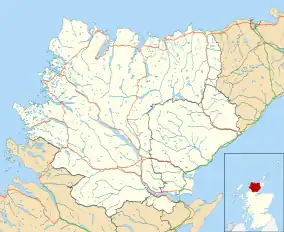| Achiemore | |
|---|---|
 Empty house at Achiemore | |
 Achiemore Location within the Sutherland area | |
| OS grid reference | NC360679 |
| Council area | |
| Lieutenancy area | |
| Country | Scotland |
| Sovereign state | United Kingdom |
Achiemore was a crofting community located on the Cape Wrath peninsula near the village of Durness in the Scottish county of Sutherland. The hamlet is just south of the farmstead of Daill on the western shore of the Kyle of Durness. Neither place has a permanent population with the village of Durness located 2.5 miles (4.0 km) to the east. Inverness is around 120 miles (190 km) to the south.
Access
Achiemore is in the Highland Council area in the far north of Scotland. Access across the Kyle of Durness is by a small passenger ferry operating from Keoldale during the summer months. The hamlet is on the U70 road linking the ferry to the lighthouse at Cape Wrath which was built in the 1830s as a supply road for the newly opened lighthouse replacing a track which linked to an original slipway north of Daill.[1][2] Quarries alongside the road at both Achiemore and Daill were used to provide material for the building of the road.[3]
History

Between 1935 and 1938, there were around 40 people living on the cape side.[4][5][6] The farmsteads at Daill and Achiemore consisted of two or three buildings with assorted enclosures.[7][8] Up to 10 children from across the cape were known to attend a side school to Durness Primary School which was located at Achiemore. The school closed in 1947 and the whole area of the cape is now virtually uninhabited.[6][9][10] The school building stood until the early 1990s, when its roof blew off in strong winds, and its walls were taken down to strengthen the wooden bridge constructed by the Royal Marines in 1980 crossing the Daill River to the north west of Achiemore.[6][9]
Achiemore is located just outside the Cape Wrath Training Area, a military training and live firing range which has operated on the cape since the early 20th century. A military sentry post adjacent to the site of the school restricts access to the area when the range is in use.[9]
A possible site of a promontory fort is located to the north-east of Achiemore on the shore of the Kyle of Durness where drystone and turf enclosures have been surveyed.[11] A site at Eilean nan Caorach, around 2 miles (3.2 km) north of Daill is a more likely location of a promontory fort or monastery. The site has been heavily damaged by shelling and dating is difficult as a result.[12]
See also
References
- ↑ Kyle of Durness storehouse to Cape Wrath lighthouse, Royal Commission on the ancient and historical monuments of Scotland. Retrieved 2013-02-08.
- ↑ Kyle of Durness, Royal Commission on the ancient and historical monuments of Scotland. Retrieved 2013-02-08.
- ↑ Kyle of Durness to Cape Wrath lighthouse, Royal Commission on the ancient and historical monuments of Scotland. Retrieved 2013-02-08.
- ↑ Cafe at the end of the universe ... where a cup of tea is guaranteed, The Herald, 2009-06-09. Retrieved 2013-02-08.
- ↑ Mrs Jessie Morrison, Durness Archived 20 June 2015 at the Wayback Machine, Obituary, Northern Times, 2011-11-29. Retrieved 2013-02-08.
- 1 2 3 Uney.G (2009) Backpacker's Britain: Northern Scotland: thirty two and three day treks, p. 86. Cicerone Press Limited. ISBN 978-1-85284-458-5 (online). Retrieved 2011-01-28.
- ↑ Daill, Royal Commission on the ancient and historical monuments of Scotland. Retrieved 2013-02-08.
- ↑ Achiemore, Royal Commission on the ancient and historical monuments of Scotland. Retrieved 2013-02-08.
- 1 2 3 Achiemore, Royal Commission on the ancient and historical monuments of Scotland. Retrieved 2013-02-08.
- ↑ Durness Schools, Education in Sutherland, 2009-03-29. Retrieved 2013-02-09.
- ↑ Daill promontory fort (possible), Royal Commission on the ancient and historical monuments of Scotland. Retrieved 2013-02-08.
- ↑ Eilean nan Caorach, Royal Commission on the ancient and historical monuments of Scotland. Retrieved 2013-02-08.
External links
- Cape Wrath tourism Archived 19 October 2015 at the Wayback Machine
- Cape Wrath ferry
- Cape Wrath Training Area, Ministry of Defence information, including access information and contact telephone numbers